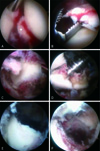Abstract
There has been a variety of options for treatment of femoral head fracture with hip dislocation according to the Pipkin classification. Pipkin type I fractures with minimal displacement have been treated conservatively. However, in cases where the fracture was displaced or reduced incongruently, it has been treated by open fragment excision or fixation after reduction. In our case, the patient was a 62-year-old man who sustained a displaced fracture of Pipkin type I. We achieved a satisfactory outcome by arthroscopic excision of a displaced bony fragment and small bony fragments that could not be confirmed by pre-operative imaging study. Therefore, we report on the case with a review of the literature.
Figures and Tables
Fig. 1
(A) The right hip was dislocated posteriorly and femoral head fracture was seen. (B) Closed reduction was done. But femoral head fragment (arrow) was displaced reversely. (C) Computed tomographic image of the right hip showed reversely displaced femoral head fragment.

Fig. 2
(A) Avulsion bony fragment with ligamentum teres (asterisk) was seen. (B) It was excised. (C) In peripheral portion, there was a large bony fragment. (D) The bone fragment was too large to be removed through portal, so we decide to crush the fragment to pieces by awl. (E, F) After removal, there was no any other fragment.

References
1. Sahin V, Karakaş ES, Aksu S, Atlihan D, Turk CY, Halici M. Traumatic dislocation and fracture-dislocation of the hip: a long-term follow-up study. J Trauma. 2003; 54:520–529.

2. Lansford T, Munns SW. Arthroscopic treatment of Pipkin type I femoral head fractures: a report of 2 cases. J Orthop Trauma. 2012; 26:e94–e96.
3. Park MS, Her IS, Cho HM, Chung YY. Internal fixation of femoral head fractures (Pipkin I) using hip arthroscopy. Knee Surg Sports Traumatol Arthrosc. Published online January 9, 2014; doi:10.1007/s00167-013-2821-4.

4. Matsuda DK. A rare fracture, an even rarer treatment: the arthroscopic reduction and internal fixation of an isolated femoral head fracture. Arthroscopy. 2009; 25:408–412.

5. Mullis BH, Dahners LE. Hip arthroscopy to remove loose bodies after traumatic dislocation. J Orthop Trauma. 2006; 20:22–26.

6. Asghar FA, Karunakar MA. Femoral head fractures: diagnosis, management, and complications. Orthop Clin North Am. 2004; 35:463–472.

7. Stannard JP, Harris HW, Volgas DA, Alonso JE. Functional outcome of patients with femoral head fractures associated with hip dislocations. Clin Orthop Relat Res. 2000; (377):44–56.

8. Chen ZW, Lin B, Zhai WL, et al. Conservative versus surgical management of Pipkin type I fractures associated with posterior dislocation of the hip: a randomised controlled trial. Int Orthop. 2011; 35:1077–1081.





 PDF
PDF ePub
ePub Citation
Citation Print
Print




 XML Download
XML Download